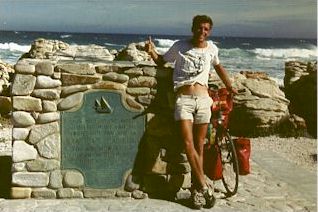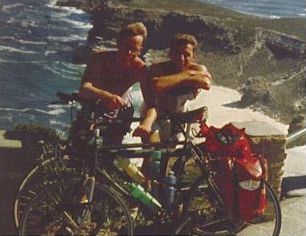 |
The odometer stands at 21105 km, we have finally reached the southern most point of Africa, Cape Agulhas. It's been 1 year, to the hour, since we first set foot on this continent at Tunis. The storm wind that rippled our tents last night and made our approach a real battle is bound to persist in the last 250 km to Cape Town. We have found lodging with a very friendly family and I have some time to reflect on this last stage:
the last 300 kms in Zimbabwe lead us through a scarcely populated arid bushveld. The few farmers of this region complain about poor rainfall and I am not surprised since it has only recently been declared semi-desert. We cross our last border, the Limpopo river,on my birthday. Excepting the crocodiles in the water, the barriers are reminiscent of the
The difference in standards of living becomes immediately apparent to a cyclist. As hours later, staring in amazement at a well-organized supermarket. It is well stocked up with familiar products. We will now have the opportunity to do our grocery shopping in one of these regularly along the way. Passed are the days of worrying over food sources! We are surprised by an overwhelming hospitality, and an elderly lady who invites us into her caravan lovingly prepares my birthday diner. Camping is very popular here and a considerable amount of people live in caravans to avoid high rental fees. Heavily loaded bicycles are not often seen in this country where long distances between villages keep people from traveling by bike, so we don't go unnoticed and are often invited to spend the night. We are also warmly welcomed at farms and police stations when in need of shelter for the night. We even get to spend a night in a hotel at no charge for sharing our experiences. The African continent is widely unknown to South Africans as most of the countries of the continent use to prohibit their entry.
 |
We chose the freeway to enter into Johannesburg, the Capital of the Transvaal province, and after a quick sum up of our journey to a policeman, we are merely cautioned and allowed to proceed. After initial difficulties, we are soon acclimatized to skylines and traffic of this goldmine city. We come from Frankfort after all!
We do a tour through the notorious township of Soweto where we are introduced to a different life altogether. Yes, apartheid is a concept of the past, officially, and Blacks are allowed to settle in previously "Whites only" areas and suburbs, most still remain in Soweto. The population outweighs that of the entire Johannesburg area. It is a city in itself that houses a wide spectrum of shacks and make-shift camps, brick-houses as well as mansions like that of the ANC leader Nelson Mandela.
Until recently, this country was paradoxically governed by a white majority, but most South Africans we meet do not oppose a multi racial government any longer. On farms however, we often make acquaintance with the traditional conservatism of the Boers. Here prevails a fear of disownment of white properties as seen in Zambia. There are even thoughts of a civil war against a chosen black government. The hatred on some of these faces and their separist behaviour speaks louder than all talk about ended apartheid. This suppression of blacks by whites is kept neatly in place and emotionalizes the the two fronts, this obscures any bases for future negotiations.
From Johannesburg, we continue passing villages with familiar names like Heidelberg and Frankfurt (originally German settlements), crossing the strenuous Drakensberg mountains to reach Durban(capital of Natal province) on the Indian Ocean. It's hot and humid as expected. The climate changes rapidly however as we carry on along the so-called "Garden Route" entering the Cape Province at Port Elizabeth. The nights are becoming increasingly chilly as we venture further down this route with it's evergreen needle trees and fynbos.
A thousand of kilometers have been cycled since crossing the Tropic of Capricorn and the autumn condition are making themselves felt. The days are temperate and skies are clear. Beautiful beaches on the southern edge of the continent make ideal resting places. We trans cycle the "homelands" of Transkei and Ciskei where the standard of living is comparable to other African countries. These questionable areas were foreseen with own government and border post but not supported or funded. Mismanagement and overgrazing have ruined most of the landscape.
Since our arrival in March 1991, this country has undergone changes as few others have. Witnessing the transition from an avoided and an excluded separatist country to a democratic, multi racial one, with boundless cultural reaches and breathtaking landscapes has been most rewarded. I do hope that with lifted sanctions more white South Africans will take the chance to learn more about this continent and its inhabitant's tolerance. Of all countries we have visited this must be the most diverse, it's infrastructures are highly developed which make travelling easy and pleasurable.
 |
Jens and I have been living in Cape Town permanently
since 1993. South Africa has become our home and we have never regretted this
decision! When cycling along the coast of Table Mountain or guiding tours throughout South Africa, we have to say we are happy to live in this
most beautiful part of the world!
To download page Beginning of page To cycletour-overview